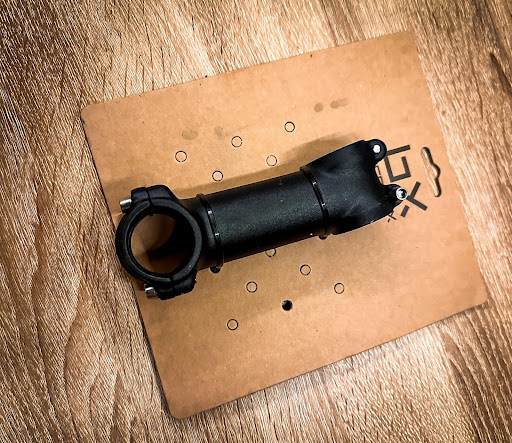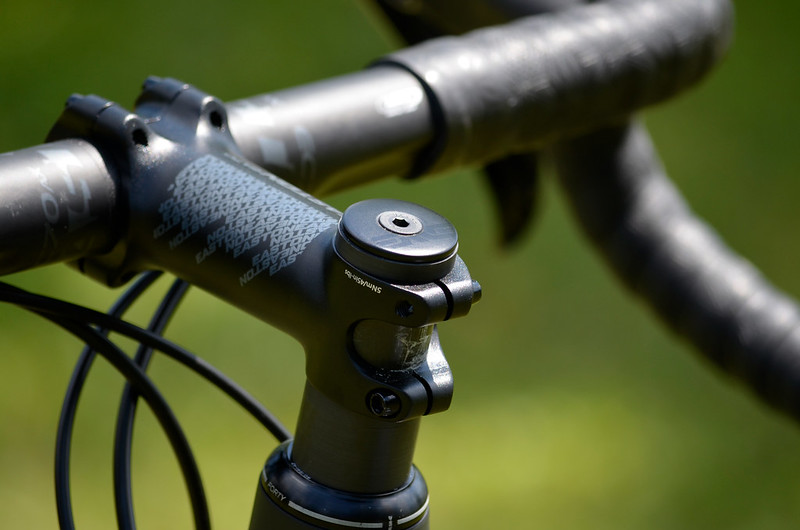When it comes to cycling, there’s a lot to learn about equipment. Bikes come in all shapes and sizes and so do the parts that they are equipped with. To fully understand bikes and all the different parts would take a lot of learning. We are lucky enough to often get asked many questions about bikes and parts, and we take great pleasure in answering them for you.
A question our readers often ask us is, “how is a stem measured?” In this article, we’re going to be telling you all about what a stem is, what it does, why they come in so many different sizes, and finally, how to measure them.
What is a Stem?

A stem is a part of the bike that sits between the handlebars and the fork’s steerer tube. They come in all different shapes and sizes, and some are made unique to certain bikes. Classic stems were made of steel or aluminum and are often referred to as a quill stem. Modern days stems are normally made of aluminum or carbon fiber and generally are much larger than a classic stem.
What Does a Stem Do?
A stem has a few different purposes, and your bike isn’t going to work very well without one. Here’s the purpose of a stem;
It helps you turn
The first thing to mention is it gives you the ability to turn the forks. The handlebars are connected to the stem, so when they move in turn, so does the stem and then the forks.
It can change the position of the rider
Stems are pretty universal, and most of them come in one mounting size on modern bikes. Stems come in all different lengths, and they are essential to getting the perfect riding position on the bike for each different user. It’s very common that bike fitters will keep lots of different lengths of stems when fitting a client.
It can change the characteristics of the bike
Just like you change a stem to change the rider’s position, you can use a stem to make a bike handle differently. You will notice that on certain disciplines of bikes, they generally will have different sized standard stems.
- Road Bikes 80-120mm
- Mountain Bikes 40-80mm
- Gravel Bikes 60-100mm
The longer the stem, the less responsive the handling becomes, meaning it is much more stable. The shorter the stem, the more responsive the bike becomes, making it very agile but more erratic.
This is why you will see mountain bikes with shorter stems, as you typically need to turn quickly and sharply. Then road bikes with longer stems, as generally on a road bike, you tend to lean more and don’t require the handlebars to turn much. Then we have gravel bikes which sit in between as they need a bit of both.
Why Do Stems Come in So Many Sizes?

Stems come in a huge variety of different sizes. The smallest stems you will find in a bike shop are around 35mm, and the largest stems are around 140mm. They typically go up in size in 10mm increments.
The rule book is completely thrown out when it comes to professionals. Professional riders are often seen on custom made stems that go to the single mm. Australian UCI Continental team rider Leigh Phillips is known to use a 190mm stem in some races, which is unbelievable.
Stems come in so many sizes because there are so many different bikes on the market that come in so many different shapes alongside so many different riders who also come in various sizes. So we need loads of different stems to match everyone up to their bikes.
How Do We Measure a Stem?
A lot of cyclists don’t understand how to measure a stem, and this is because it is done in a very unique way. Here’s our step by step guide to measuring a stem that can be done on or off the bike. You’re going to need a tape measure or a vernier caliper.
Step One: Get a stem
The first thing you need to do is to get yourself the stem ready to measure. It can be on a bike or off a bike. It doesn’t make any difference.
Step Two: Locate the center of the top cap

The first thing you are going to need to do is to locate the center of the top cap. This can be easily found by going to the center of the steering tube and where the bolt is at the top is where you want to put your first measuring point.
Step Three: Locate the center point of the handlebar clamp

Now you have your first marker point on the top cap. It’s time to go to the part of the stem which clamps the handlebars. As pictured below, you need to set your second measuring point in the center of the handlebar clamp. Take a measurement and write it down before you forget it, and this is the length of the stem that you have. Here we have 90mm.
Step Four: Measure the handlebar clamp size

Then using the vernier caliper, we recommend clamping the handlebars where it attaches to the stem and taking this measurement too, as this can come in various sizes as well. It will be 26mm on older bikes or 31.8mm on newer ones.
What Size Stem Do I Need?
It can be very challenging to know what size of stem you might need. We recommend that if you feel you are being stretched forward too much and suffer from lower back pain, you might want to shorten the length of your stem.
If you feel cramped and the bike feels too small for you, you might want to use a longer stem instead. This will stretch you forward and give you more room for you to move around.
If you want the perfect stem size, we recommend seeing a proper bike fitter, as they can tell you exactly where you need to be by looking at your bike and you personally.
Conclusion
Most cyclists, at some point, want to change their stems. It may be because they have a new bike and need it more fitted, or they might want to change the characteristics of how their bike rides. Whatever the reason, changing a stem can completely change the way your bike feels and rides. We highly recommend learning how to measure your stem so you know which size you will need to change it out with.
